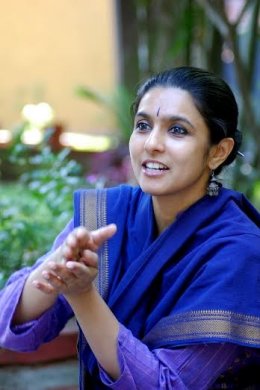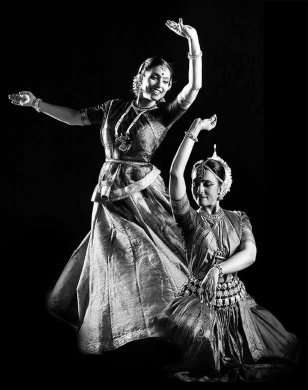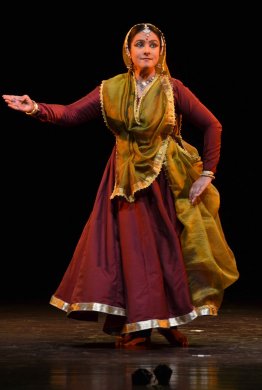
|   |

|   |
 e-mail: ukb7@rediffmail.com The making of Mahagami February 20, 2018  How does a performing arts institution in India germinate, grow and gather momentum? What are its birth pangs like? How does it overcome the initial hurdles and hardships? What kind of planning process is called for at its multiple stages of progress, with a sampling of its products? And, can there be a final cheer alongside a cherished dream? Here is the connected story - from absolute nothing to a near pinnacle of sweet success of Mahagami Gurukul in Aurangabad, the heritage city of India, providing the gateway to Ajanta and Ellora. At its core has to be a seed of demand-supply matching, even for performative arts which need to create its own environment. As a wit observed, "Culture is man-made environment." Within the 70-acre arid campus of Mahatma Gandhi Mission, its spirited Chairman had an early vision of a centre of technology, medicine, fine arts, dance, music and a lot besides. Einstein said once, "Visions are only hallucinations, until experimented." MGM Chairman and his Secretary - both staunch Gandhians and devout art-lovers - believed that education in its different forms could change the face of society and took on the daunting task to transform a barren land into a universally accepted learning centre where students from different shores would gather to get groomed in sundry disciplines. To them, Mahagami Gurukul could be a dream-oasis of calm tranquility - amidst the hustle-bustle of a crowded campus - where the future artiste would feel de-stressed within the lush green foliage and Warli painted walls around. If this was the demand side, the supply side took literally a year to mature. MGM Secretary had been told - from Bharat Bhavan and Goa Kala Kendra - of a certain Bhopal girl, with scientific upbringing in Mathematics and Computer Engineering, and qualified in both Kathak (under Pt. Birju Maharaj) and Odissi (under Gurus Kelucharan Mohapatra and Madhavi Mudgal) who could probably meet the bill. Based in Delhi then, she was working in IGNCA under Dr. Kapila Vatsyayan and had joined Kathak Kendra Repertory, with no intention to leave Delhi - a happening place according to her. This was the demure Parwati Dutta who summarily rejected the MGM offer in 1995. The offer was renewed after one year through her Bhopal based parents and on Air France's Sao Paolo bound flight from Paris for a two month stint in Brazil, she had the hunch that she should join MGM. When she was back, the loss to the Indian capital was a gain to Aurangabad.  Though not quite, for, the forlorn grounds of MGM campus and no friendly soul to receive her on her first day of arrival - by a passenger train from Manmad - she was virtually prepared to return by the evening. Providence intervened; she stayed back and just one solitary journey to Delhi and back notwithstanding, she has stayed on ever since in order to build her very own Mahagami Gurukul, literally brick by brick, sapling by tender sapling. Today, after 20 years, one finds the entire space filled with cozy cottages providing comfortable accommodation, an aesthetically-designed 'Sadhanalaya' with large mirrors, audio systems and musical instruments, a well stocked library of precious books, a 'Baithak Sangraha,' an open-air stage 'Dyava-Prithvi' seating 350 viewers, 'Parna-Kuthi' as its dining cottage, and 'Kriti-Kon' as an outlet to cater for the academic, aesthetic and artistic needs of students and the art debutante. Right from the opening on Guru Purnima evening in 1996, the road-map of growth for Mahagami remained uneven, to say the least. Teaching started from the same cottage where Parwati stayed and was given free of cost for some years, with Parwati as the sole guru. Birju Maharaj visited MGM in 1997 and advised her whole-heartedly against continuing here. Kelubabu came in 1998 and advised to the contrary, insisting on sharing meals in the open along with the rest. Her first choreographic work with the students came to fruition within four years for Vasantotsav in Delhi in 2000 and group choreography on forts of India featured at Old Fort in Ananya festival, which impressed this critic right away. Parwati also began a Vaithak in different performing arts with local talents and started Sanskrit teaching to provide an understanding of Indian culture. Dr. Tarlekar, the erudite Marathi translator of Sarangadev's Sangeet Ratnakar, provided grounding in that 13th century, performing arts treasure conceived in this very soil. She also established a library, laid foundations for research activities and began teaching choreography. Yet, by 1999, it was amply clear that classical arts were invisible in the region, barring some stray Hindustani vocal concerts, and dances confined to rudimentary Bharatanatyam classes. In the prevailing mindset, dance was held as lowbrow, with a complete absence of discourse and dialogue around the arts. Parwati's efforts were viewed with deep suspicion and she soon met with stiff resistance from the locals, which surprisingly included musicians who were most unwelcoming to her presence. Repugnant to an 'outsider' in their midst, they figured, how could a woman 'educate' them on culture? Threats from the conservative fringe followed, telephone lines were disconnected, and finally, her cottage was ransacked, everything valuable lost and an ultimatum given to her to leave. The myth of the 'most welcoming small city' was shattered for Parwati, scared and unable to eat for days. In the formal science of cybernetics - about the control of an environment by using negative feedback of information - there is a cardinal 'law of requisite variety': one's own variety of control measures ought to match the variety of what one seeks to control. Instinctively, Parwati realized the hard truth, that hand in hand with her institution building for the initiated, she must engage variously with grassroots, create arts awareness across the board in her given Marathwada region and carry arts education even to the most deprived. One by one, a dispirited, but defiant, Parwati started executing her self-appointed, multi-pronged tasks.  Anubhuti was her regular multimedia arts appreciation session where the layman was introduced to the basics of dance and information on India's rich cultural heritage was shared, to create an intellectually aware audience for the performing arts. Over time, this programme covered different kinds of people - including auto drivers and even prisoners - to make Aurangabad culturally a richer place. Sahriday was a monthly 'baithak' involving local musicians, where her students also performed. In alternate months came Drishtikon as a series of lecture-demonstrations by gurus, alongside perhaps a physicist explaining harmonics, an architect and a Sanskrit scholar providing food for thought. Vidya-Aranyam was her initiative that extended to English and Marathi schools to experience 'unique dwelling in the green for Vidya, in the Gurukul cottages amidst lush surroundings with a focus on academics, novel learning streams, innovative skills and child development domains. Swayam-Siddha involved mentally challenged children who initially showed some resistance, but gradually opened up when their bodies responded and their minds got focused, able to use symbolic gestures for sun, birds, clouds and rain. On World Dance Day of 29 April 2015, Dance beyond Barriers featured the excited toddlers performing what they had learnt to an enraptured audience giving them a standing ovation and the happy children clapping away, reluctant to leave! Sadhana was for the inmates an intensive yearly training Gurukul camp, with students staying on the campus for the entire duration of 10-15 days, involved in intensive practice of their chosen art form, exposed to Yoga exercises, Sanskrit lessons, medical check-up and special nutritious diets; and taught pottery, wall painting, weaving. The camps were open to age-brackets of 10-50 years of age, and there were mini-camps for the below 10 age group. Aura Aurangabad encompassed the entire heritage city - inclusive of inhabitants and tourists - holding 20-30 ticketed concerts every year on the weekends, with invited young artistes to perform. This has been made into a self-supporting project and made part of 'corporate social responsibility' for the local business and industry. The effort is to create an entire eco-system: so much for the perception of 'requisite variety'! On the research side, Sahachar is an inter-disciplinary collaboration involving chess and other combative games, while Nirupan covers translation projects of the Oriya Champu Kavya into Hindi, Marathi and English, and Abhinaya Chandrika into Marathi. Darpan seeks to create performing arts study material in three languages, whereas Sanchaya attempts at archiving Chitrakathi, Dhrupad music, pakhawaj percussion - styles of 50 Dhrupad gurus - complete with digital documentation. A feather in the Mahagami cap has been the ISO 2000 certification - as the world's first 'Arts Organisation Archive' - and recognition of its emphasis on "spiritual excellence" by RINA, the audit firm from Italy, included in the Quality Manual for Kala Avilashi ('art-seeker') for Gurukul. Indeed, the Manual contains clauses for processes and products like Jnana Vardhana of disciples as well as Kala-drishti Vardhana of society, both of which were much appreciated by the Italian auditors.  Meanwhile, the choreographic oeuvre has been growing in range and complexity. Vaari was a contemplative narrative on the wisdom and teachings of the 13th century Marathi saint-poet Gyaneshwar, illustrating the great sage's life - of humiliation, rejection, confrontation, courage, compassion, surrender and submission. Vadya-Pallavi, unlike Odissi's customary Swara-Pallavis, was inspired by the rhythmic element and percussion of Odissi. Ajaraa was an invocation to the Rigvedic river of Saraswati, whose ageless, invisible flow sustains all. Panchatmika was an exploration of five dance styles: Odissi, Kathak, Bharatanatyam, Kuchipudi and Mohiniattam, articulating the five-fold interpretation of creation, existence and evolution. Nrityangan was an Odissi production representing the legends and sculptures of Ellora Caves. Varnajaa was a unique expression of sound, idea and inspiration through form to create calligraphic images through Kathak. Mama chitte niti nritye… was a visualisation of multiple Tagore songs, beginning with, In the deep shadows of the rainy July, you walk with secret steps, silent as night… On cultural eco-system, Parwati has this to say, "I have often wondered at the dynamism of an organisation, which comprises its inner spirit, its form and its character. Like a sensate being, the organisation does have its intrinsic existence and an inherent design for future growth and expanse that regulates its longevity. This brings me closer to the concept of an eco-system, which we know to be a community of living organisms in conjunction with the non-living components of their environment, interacting as a system… I have been a witness to the birth, growth and challenges of Mahagami and often felt that the way it has gradually taken shape and has evolved over years is due to a strong regulatory force that is a blend of the individual faith and efforts, and the innate energy of its surroundings, which again has been consciously created over a period of time." And here is the delineation of her dreams, "In two decades of journey, the horizon is re-discovered, each time translating a few dreams into reality, while there are many still unrealised. The future plans of Mahagami includes setting up an audio-visual studio to gear up documentation and research activities; giving financial assistance to promising artists; expanding the infrastructure for long-term residential programmes; establishing a repertory unit; introducing a full-time dance curriculum, supplemented by formal education; preserving the dying performative traditions of India; and reviving the cultural history of Marathwada region. One of the most cherished dreams would be to make the region breathe with the refined understanding of art and evoke an 'art seeker' within everyone..."  Dr. Utpal K Banerjee is a scholar-commentator on performing arts over last four decades. He has authored 23 books on Indian art and culture, and 10 on Tagore studies. He served IGNCA as National Project Director, was a Tagore Research Scholar and is recipient of Padma Shri. Post your comments Please provide your name and email id when you use the Anonymous profile in the blog to post a comment. All appropriate comments posted with name & email id in the blog will also be featured in the site. |